|
SUMMARY
Sir Frank J. Whittle
- Pioneer Developer Of Turbo-jet Aircraft Engines
Sir
Frank J. Whittle experimented with and constructed turbo-jet engines in
pre-World War II England. In 1929 he patented a turbo-jet engine and in
1937 proved to skeptical British Air Ministry officials that a jet
powered aircraft was feasible.
In
1941, a Gloster E28/39 research aircraft was fitted with a Whittle
"W.1" engine that produced 800 pounds of thrust. The aircraft
reached 466 miles per hour and climbed to 42,000 feet, exceeding all
speed and altitude limitations of that period. The success of the
Whittle "W.1" turbine engine propelled England into the jet
age.
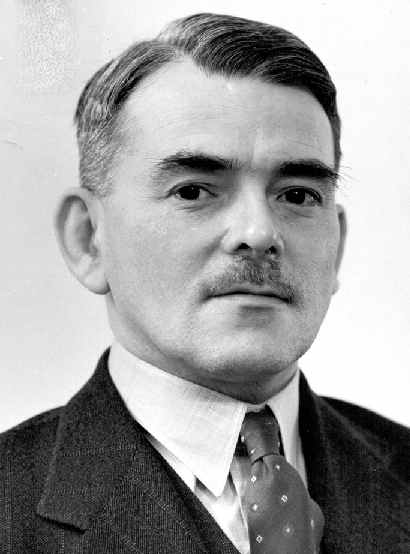
Frank
J. Whittle
Whittle's
formal training was in mechanical engineering. During the war he rose to
the rank of air commodore in the Royal Air Force and served as technical
advisor to the Ministry of Supply. He retired from the RAF in 1948 and
in the same year was knighted because of his contributions. He was later
awarded the United States Legion of Merit and the Royal Aeronautical
Society gold medal.
EARLY
LIFE
Air
Commodore Sir Frank Whittle, OM, KBE (1 June 1907–9 August
1996) was a Royal
Air Force officer
who invented the jet engine. Due to funding and manufacturing problems,
and a lack of forsight on the part of the British Government in keeping
sensitive patents secret, Hans von Ohain of Germany
was able to beat him to production models, but Whittle's work and
tireless efforts to produce his designs given official lack of interest
are legendary. By the end of the war, Whittle's efforts and Britain's
superior high-temperature alloys resulted in engines that led the world
in performance for the next decade. Whittle and Ohain met after the war,
and initially Whittle was angry with him as he felt Ohain had stolen his
ideas. Ohain eventually convinced him that his work was truly
independent, and after that point the two became good friends.
Whittle
was born in Earlsdon, Coventry, England
on June 1, 1907, the son of a mechanic. He left Leamington College in
1923 to join the RAF.
Through his early days as an Aircraft apprentice (first at RAF Cranwell
but latterly at RAF Halton) he maintained his interest in the Model
Aircraft Society where he built replicas, the quality of which attracted
the eye of his commanding officer, who also felt that Whittle was a
mathematical genius.
He
was so impressed that he recommended Whittle for the Officer Training
College at Cranwell in Lincolnshire in 1926, a rarity for a
"commoner" in what was still a very class-based military
structure. For Whittle this was the chance of a lifetime, not only to
enter the officer's corps, but also because the training included flying
lessons. Of the few apprentices that were accepted, only about one
percent completed the course. Whittle was the exception to the rule,
graduating in 1928 at the age of 21, ranked second in his class in
academics and an "Exceptional to Above Average" pilot.
Another
requirement of the course was that each student had to produce a thesis
for graduation. Whittle decided to write his thesis on future
developments in aircraft design, notably high-speed flight at high
altitudes and speeds over 500 mph (800 km/h).
He showed that incremental improvements in existing propeller engines
were unlikely to make such flight routine. Instead he described what is
today referred to as a motorjet, a motor using a conventional piston
engine to provide compressed air to a combustion chamber whose
exhaust was used directly for thrust – essentially an afterburner
attached to a propeller engine. The design was not a new one, it had
been talked about for some time in the industry, but Whittle's interest
was to demonstrate that at increased altitudes the lower outside air
pressure would increase its efficiency. For long-range flight, using an
Atlantic-crossing mailplane as his example, the engine would spend most
of its time at high altitude and thus could outperform a conventional
powerplant.
JET
ENGINE DEVELOPMENT
Whittle
continued working on the motorjet principle after his thesis work, and
eventually abandoned it when further calculations showed it would weigh
as much as a conventional engine of the same thrust. But as he later
described, while thinking about the idea he thought "Why not
substitute a turbine for the piston engine?" Instead of using a
piston engine to provide the compressed air for the burner, a turbine
could be used to extract some power from the exhaust and power an actual
compressor, like those used for superchargers. The leftover exhaust
thrust would power the aircraft.
In
July 1926, A. A. Griffith published a paper on compressors and turbines,
which he had been studying at the RAE. He showed that such designs up to
this point had been flying "stalled", and that by making the
compressor blades into an aerofoil shape, their efficiency could be
dramatically improved. The paper went on to describe how the increased
efficiency of these sorts of compressors and turbines would allow a jet
engine to be produced, although he felt the idea was impractical and
instead suggested using the power as a turboprop. At the time most
superchargers used a centrifugal compressor, so there was limited
interest in the paper.
Whittle
sent his new idea to the Air Ministry to see if there would be any
interest. With little knowledge of the topic they turned to the only
other person who had written on the subject, and passed the paper on to
Griffith. Griffith appears to have been convinced that Whittle's
"simple" design could never achieve the sorts of efficiencies
needed for a practical engine. After pointing out an error in one of
Whittle's calculations, he went on to comment that the centrifugal
design would be too large for aircraft use, and that using the jet
directly for power would be rather inefficient. The RAF returned comment
to Whittle, where they referred to the design as
"impracticable."
Others
in the RAF were not so sure, and in particular Johnny Johnson convinced
him to patent the idea in January 1930. Since the RAF was not interested
in the concept they did not declare it secret, which meant that Whittle
was able to retain the rights to the idea, which would have otherwise
been the property of the RAF. This rejection would later turn out to be
a stroke of luck.
Meanwhile
Whittle moved onto the Officers' Engineering Course at RAF Henlow,
Bedfordshire in 1932, and then to Peterhouse, Cambridge in 1934,
graduating in 1936 with a First in the Mechanical Sciences Tripos.
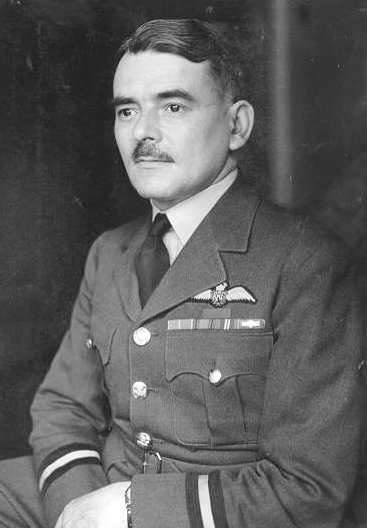
Commodore
Whittle
POWER
JETS
Whittle's
jet engine patent lapsed in 1935 because he could not afford the renewal
fee of £5. But soon after this he was approached by two ex-RAF men,
Rolf Dudley-Williams and J. Tinling, who wanted to expand the
development of his engine. The three incorporated as Power Jets Ltd.
in 1936 with a bank loan of £2,000. Work was started on an experimental
engine at a factory in Rugby, Warwickshire belonging to British
Thomson-Houston, a steam turbine company. The RAF still saw no value in
the effort, but although Whittle was still a pilot they placed him on
the Special Duty List and agreed to allow him to work on the design as
long as it took no more than six hours a week.
Funding
development of the first engine, known as the WU (Whittle Unit) was a
serious problem. Although privately funded, most potential investors
shied from a project that appeared to be semi-secret yet had no RAF
backing. Something seemed to be amiss; if the project was going to work,
why didn't the RAE fund it? Once again it seemed not everyone was so
unconvinced of Whittle's ideas, and in October 1936 Henry Tizard, the
rector of Imperial College London and chairman of the Aeronautical
Research Committee, sent details of Whittle's engine to Griffiths once
again. Griffiths had by this time started construction of his own
design; perhaps in order to avoid tainting his own efforts, he returned
a much more positive review. He remained highly critical of some
features, seemingly ignoring the fact that its performance at high speed
and altitude was the crucial aspect of the programme.
Even
with these problems Power Jets were able to complete the WU, which ran
successfully on April 12, 1937. Tizard pronounced it "streets
ahead" of any other advanced engine he had seen, and managed to
interest the Air Ministry enough to fund development with a contract for
£6,000 to develop a flyable version. Nevertheless it was a year before
all of the funds were available, greatly delaying development.
Meanwhile
testing continued with the WU, which showed an alarming tendency to race
out of control. Due to the dangerous nature of the work being carried
out, in 1938 development was largely moved from Rugby to the BTH's
semi-disused Ladywood foundry at nearby Lutterworth in Leicestershire.
There was a successful run of the WU there in March 1938. Although the
potential of the engine was obvious, the Air Ministry remained focused
on the practical issues of gearing up production of existing piston
engine designs.
All
of these delays and the lack of funding had seriously delayed the
project. In Germany, Hans von Ohain had started work on a prototype in
1935 and had already passed the prototype stage and was building the
first flyable design, the Heinkel HeS 3. There is little reason to
believe that Whittle's efforts would not have been at the same level or
even more advanced had the Air Ministry taken a greater interest in the
design. When the war started in September 1939, Power Jets had a payroll
of only 10, and Griffith's efforts at the RAE and Metropolitan Vickers
were similarly small.
The
stress of the continual on-again-off-again development, and problems
with the engine itself, had a serious toll on Whittle. He suffered from
stress-related ailments such as eczema and heart palpitations, while his
weight dropped to 126 pounds (57 kg). In order to keep to his
sixteen-hour workdays, he sniffed Benzedrine during the day, and then
took tranquilizers and sleeping pills at night to offset the effects and
allow him to sleep. Over this period he became irritable, and developed
an "explosive" temper.
Following
the outbreak of World
War II the Air Ministry changed priorities and once again looked at
the various advanced projects underway. By 1939, Power Jets could barely
afford to keep the lights on when yet another visit was made by Air
Ministry personnel. This time Whittle was able to run the WU at high
power for 20 minutes without any difficulty. One of the members of the
team was the Director of Scientific Research, H. E. Wimperis, who walked
out of the demonstration utterly convinced of the importance of the
project.
A
contract for full-scale development was immediately sent to Power Jets,
along with a number of tenders to various companies to set up production
lines for up to 3,000 engines a month in 1942. Power Jets had no real
manufacturing capability, so the Air Ministry offered shared production
and development contracts to BTH, Vauxhall
and Rover.
However, the contract was eventually taken up by Rover only. They also
sent out a contract for a simple airframe to carry the engine, which was
quickly taken up by Gloster.
Whittle
had already studied the problem of turning the massive WU into a flyable
design, and with the new contract work started in earnest on the
"Whittle Supercharger Type W.1." However, Rover
was unable to
deliver the W.1 production engine before Gloster's experimental airframe
was ready. Whittle then cobbled together an engine built from various
test parts and called it the W.1X, which ran for the first time on
December 14, 1940. This engine powered the Gloster E.28/39 for taxi
testing when it took to the air for a short hop on April 7, 1941.
Archive
film of the early secret E.28 tests still exists. It illustrates the
vivid memories of ordinary folk living nearby who were interviewed by
the BBC a decade later. They recall their amazement that an aeroplane
could fly with no propellers and the questions is raised in local pubs
at the time: how could it possibly work? Did the mystery aircraft
somehow suck itself through the air like a supercharged vacuum cleaner?
It was difficult for laypeople still used to conventional aircraft to
imagine that jet propulsion could work in practice.
The
"full" W.1 of 3.8 kN (850 lbf) thrust ran on April 12, 1941,
and on May 15, 1941 the W.1-powered E.28/39 took off from Cranwell at
7.40 pm, flying for seventeen minutes and reaching a maximum speed of
around 545 km/h (340 mph). Within days it was reaching 600 km/h (370
mph) at 7600 meters, exceeding the performance of the contemporary Spitfires,
astounding considering this was the very first such engine. Success of
the design was now evident to all, and nearly every engine company in
England started their own crash efforts to catch up with Power Jets.
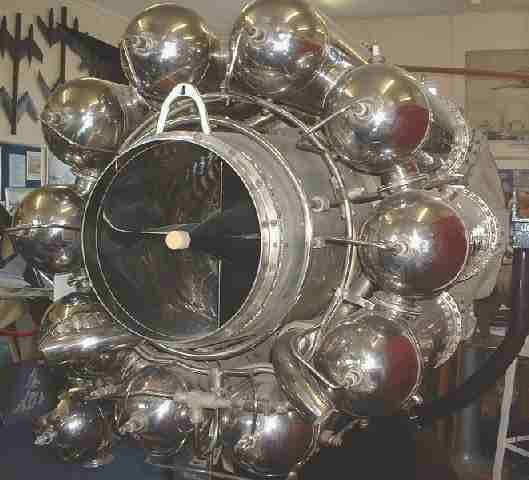
The
W2/700 engine flew in the Gloster E.28/39, the first British
aircraft
to
fly with a turbojet engine, and the Gloster Meteor
A
newer design known as the W.2 was then started. Like the W.1 it featured
a "reverse flow" design of the burners, in which the heated
air from the flame cans was piped back towards the front of the engine
before entering the turbine area. This allowed the engine to be
"folded", with the flame cans lying around the turbine area,
and therefore making for a shorter engine.
Power
Jets also spent some time in May 1940 drawing up the W.2Y, a similar
design with a "straight through" airflow that resulted in a
longer engine and (more critically) driveshaft, but with a somewhat
simpler layout. In order to reduce the weight of the driveshaft as much
as possible, the W.2Y used a large cylindrical shaft almost as large as
the turbine disk, "necked down" at either end where it
connected to the turbine and compressor.
The
Air Ministry was eager to obtain an operational jet aircraft, and
authorised BTH to press ahead with a twin-engined jet interceptor, which
would evolve into the Gloster
Meteor. The Meteor was intended to use either the W.2 or the similar
Halford H.1 (later named "Goblin") but de Havilland later
decided to keep all the Halford's for their own design, the de Havilland
Vampire.
The
Power Jets name would again see use in the form of PowerJet, a 50/50
joint venture between Snecma Moteurs of France, and NPO Saturn, of
Russia to produce an engine for the Russian Regional Jet.
Rover
In
1941 Rover set up a new laboratory for Whittle's team along with a
production line at their disused Barnoldswick factory, but they also set
up a parallel effort with their own engineers at Waterloo Mill,
Clitheroe. Here Adrian Lombard attempted to develop the W.2 into a
production quality design, dispensing with Whittle's "reverse
flow" burners and developing a longer but simpler
"straight-through" engine instead. Work at Barnoldswick
continued on Whittle's original design, now known as the W.2B/23, while
Lombard's new design became the W.2B/26. Whittle was upset by this
course of events, feeling that all work should concentrate on producing
a single design as soon as possible.
By
late 1941 it was obvious to all that the arrangement between Power Jets
and Rover was not working. Whittle was frustrated by Rover's inability
to deliver production-quality parts, as well as with their "we know
better than you" attitude, and became increasingly vocal about his
complaints. Likewise Rover was losing interest in the project after the
delays and constant harassment from Power Jets.
Rolls-Royce
Earlier,
in 1940, Stanley Hooker of Rolls-Royce
had met with Whittle, and later introduced him to Rolls' CEO, Ernest
Hives. Hooker led Rolls' supercharger division, which was naturally
suited to jet engine work. Hives agreed to supply key parts to help the
project, and it was Rolls engineers who helped solve the surging
problems seen in the early engines. In early 1942 Whittle contracted
Rolls for six engines as well, known as the WR.1, identical to the
existing W.1.
The
problems at Rover became a "public secret", and eventually
Spencer Wilkes of Rover met with Hives and Hooker at the Swan and
Royal pub near the Barnoldswick factory. They decided to trade the
jet factory at Barnoldswick for Rolls' tank engine factory in
Nottingham. A handshake sealed the deal. The handover took place on
January 1 1943, although the official date was later. Rolls soon closed
Rover's parallel plant at Clitheroe, although they continued development
of the W.2B/26 that had been developed there.
Testing
and production was immediately stepped up. In December Rover had tested
the W.2B for a total of 37 hours, but within the next month Rolls-Royce
tested it for 390 hours. The W.2B passed its first 100 hour test at full
performance of 725 kgf (7.11 kN) on May 7, 1943. The prototype Meteor
airframe was already completed, and took to the air on June 12, 1943.
Production versions started rolling off the line in October, first known
as the W.2B/23, then the RB.23 (for Rolls-Barnoldswick), and eventually
the Rolls-Royce Welland. Barnoldswick was too small for full-scale
production and turned back into a pure research facility under Hooker,
while a new factory was set up in Newcastle-under-Lyme. The W.2B/26, as
the Rolls-Royce Derwent, opened the new line and soon replaced the
Welland, allowing the production lines at Barnoldswick to shut down in
late 1944.
Although
the Luftwaffe beat the British efforts by a few weeks, largely due to
the delays at Rover, Whittle's efforts were nevertheless far more
influential. The engines that powered the Meteor were much more reliable
than their German counterparts, which would typically last 10 hours or
less, and sometimes exploded on their first startup. The equivalent
British engine would run for 150 hours between overhauls and had twice
the power-to-weight ratio and half the specific fuel consumption. By the
end of the war every major engine company in Britain was working on jet
designs, and practically every other design in the world was based on
the Whittle pattern, or licensed outright. It was not until the late
1950s that most engines powering US and USSR fighters were no longer
directly related to Whittle's original work.
Continued
development
With
the W.2 now proceeding smoothly, Whittle was sent to Boston,
Massachusetts in mid-1942 to help the General Electric jet programme.
GE, the primary supplier of turbochargers in the US, was well suited to
quickly bringing jet production online. A combination of the W.2B design
and a simple airframe from Bell Aircraft flew in autumn of 1942 as the
Bell XP-59A Airacomet.
Whittle's
developments at Power Jets continued, resulting in the improved W.2/500,
and later the W.2/700. Both were fitted for testing on Meteors, the
W.2/700 later being fitted with an afterburner ("reheat" in
British terminology), as well as experimental water-injection to cool
the engine and allow for higher power settings without melting the
turbine. Whittle also turned his attention to the axial-flow championed
by Griffiths, designing the L.R.1. Other developments included the use
of fans to provide more mass-flow, either at the front of the engine as
in a modern turbofan, or at the rear, which is much less common but
somewhat simpler.
Whittle's
work had caused a minor revolution within the British engine
manufacturing industry, and even before the E.28/39 flew most companies
had set up their own research efforts. In 1939, Metropolitan-Vickers set
up a project to develop an axial-flow design as a turboprop, but later
re-engineered the design as a pure jet known as the Metrovick F.2.
Rolls-Royce had already copied the W.1 to produce the low-rated WR.1,
but later stopped work on this project after taking over Rover's
efforts. De Havilland started a jet fighter project in 1941, the
Spidercrab—later called Vampire—along with their own engine to power
it: Frank Halford's Goblin (Halford H.1). Armstrong Whitworth also
developed an axial-flow design, the ASX, but reversed Vicker's thinking
and later modified it into a turboprop instead, the Python.
With
practically every engine company now producing their own designs, Power
Jets was no longer able to generate realistic income. In April 1944
Power Jets was nationalised, becoming the National Gas Turbine
Establishment at the original Ladywood experimental site. In 1946 it
was reorganised with the RAE divisions joining them.
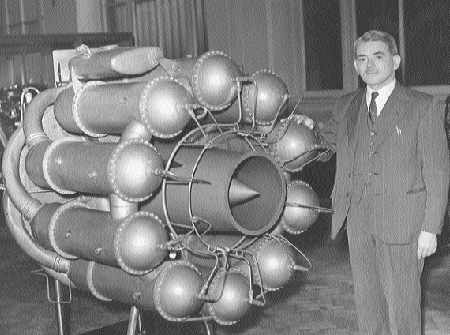
Frank
Whittle and prototype engine
After
the War
Whittle,
disenfranchised, quit what was left of Power Jets in 1948. Long a
socialist, his experiences with nationalisation changed his mind, and he
later campaigned for the Conservative Party. He also retired from the
RAF, complaining of ill health, leaving with the rank of Air Commodore.
Shortly afterwards he received £100,000 from the Royal Commission on
Awards to Inventors, partly to pay him for turning over all of his
shares of Power Jets when it was nationalised. He was made a Knight of
the Order of the British Empire (KBE) in that same year.
Whittle's
company, Power Jets - partially owned by the government - continued to
work on the development of jet engine, although need to produce them in
numbers led to involvement of other companies (Rover, then Rolls Royce
and de Havilland) and Power Jets' role diminished. Following
nationalisation of the company, Whittle resigned from board of Power
Jets in January 1946, becoming Technical Advisor on Engine Design and
Production to Controller of Supplies (Air) in June of that year.
However, the immense pressure under which Whittle placed himself during
the development of jet led to a deterioration in his health, and during
a lecture tour in the USA health, he broke down. He retired from the RAF
on medical grounds on 26 August 1948.
During
May 1948 Whittle received ex-gratia award of £100,000 from the Royal
Commission on Awards to Inventors in recognition of his work on the jet
engine. Two months later he received a Knighthood. He then became
honorary technical advisor to BOAC on the use of jet aircraft between
1948 and 1952 and wrote his memoirs, 'Jet: The Story of a Pioneer' in
1952-53. Subsequently he became technical advisor to Shell, and in 1960s
to Bristol Siddeley Engines during the development of a revolutionary
oil drill - the Whittle Turbodrill. He married his second wife, American
Hazel S Hall ('Tommie'), and emigrated to the USA 1976 where he became
Navair Research Professor at the US Naval Academy in 1977, and Adjunct
Research Professor at the Academy from 1979.
He
soon joined BOAC as a technical advisor on aircraft gas turbines. He
travelled extensively over the next few years, viewing jet engine
developments in USA, Canada, Africa, Asia and the
Middle East. He left
BOAC in 1952 and spent the next year working on a biography, Jet: The
Story of a Pioneer. He was awarded the Royal Society of Arts'
prestigious Albert Medal that year.
Returning
to work in 1953, he accepted a position as a Mechanical Engineering
Specialist in one of Shell
Oil's subsidiaries. Here he developed a new type of drill that was
self-powered by a turbine running on the mud pumped into the hole that
was used as a lubricant during drilling. Normally a well is drilled by
attaching rigid sections of pipe together and powering the cutting head
by spinning the pipe, but Whittle's design meant that the drill had no
strong mechanical connection to the head frame, allowing for much
lighter piping to be used.
Whittle
left Shell in 1957, but the project was picked up in 1961 by Bristol
Siddeley Engines, who set up Bristol Siddeley Whittle Tools to
further develop the concept. In 1966 Rolls Royce purchased Bristol
Siddeley, but the financial pressures and eventual bankruptcy due to
cost overruns of the RB211 project led to the slow wind-down and
eventual disappearance of Whittle's "turbo-drill" once again.
The design would eventually appear only in the late 1990s, when it was
combined with continuous coiled pipe to allow uninterrupted drilling at
any angle. For instance, the "continuous-coil drilling" can
drill straight down into a pocket of oil, and then sideways through the
pocket to allow the oil to flow out faster.
In
1976 Whittle emigrated to the US, and the next year he accepted the
position of NAVAIR Research Professor at the US Naval Academy,
Annapolis. His research concentrated on the boundary layer before his
professorship became part-time from 1978 to 1979. The part time post
enabled him to write a textbook on gas turbine thermodynamics. It was at
this time that he met von Ohain, who was working at Wright-Patterson Air
Force Base. At first upset because he believed von Ohain had only
developed his engine after seeing Whittle's patent, he eventually became
convinced that von Ohain's development really was his own. The two
became good friends, and often toured the US giving talks together. In
1991 von Ohain and Whittle were awarded the Charles Stark Draper Prize
for their work on turbojet engines.
Later
life
Frank
Whittle married Dorothy Lee in May 1930 and they had two sons. Whilst at
Cranwell he lodged in a bungalow at Dorrington. The marriage was
dissolved in 1976 and Whittle re-married, to Hazel Hall. He passed
away in Baltimore, Maryland on 9 August 1996.
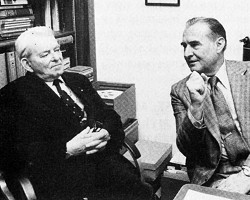
Memorials
Whittle
has several memorials, these include:
-
In
the Walsgrave surburb of Coventry, there is a school named after
Whittle. It was called Frank Whittle Primary up until 1997, before
being re-named Sir Frank Whittle primary. A jet engine replica sits
in the reception of the school, Whittle himself donating it before
his death.
Bibliography:
-
John
Golley - 'Genesis of the Jet: Frank Whittle and the Invention of the
Jet Engine' (Airlife, 1996)
-
Sir
Stanley Hooker - 'Not Much of an Engineer: An Autobiography' (Airlife,
1984)
-
Sir
Frank Whittle - 'Jet: The Story of a Pioneer' (Frederick Muller Ltd,
1953)
LINKS
-
John
Golley, Frank, Sir Whittle, Bill Gunston (1997). Genesis of the
Jet: Frank Whittle and the Invention of the Jet Engine. Crowood
Press. ISBN 1-853-10860-X.
-
David
S Brooks (1997). Vikings at Waterloo: Wartime Work on the Whittle
Jet Engine by the Rover Company. Rolls-Royce Heritage Trust.
ISBN 1872922082
INVENTORS
A - Z
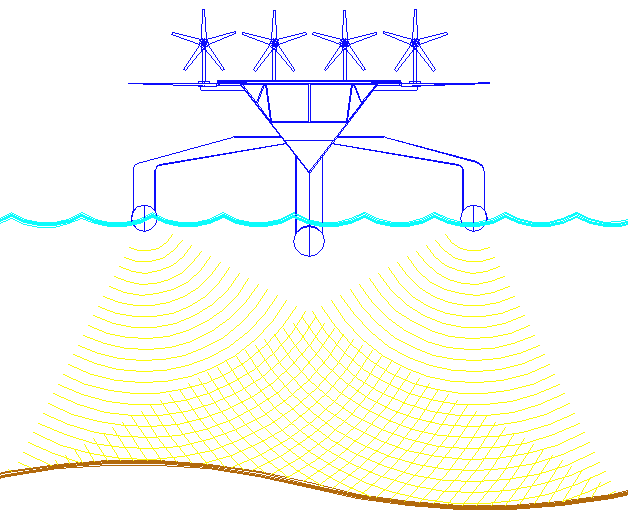
The
ultimate Robot Boat. Solarnavigator uses an advanced SWASSH
hull as the platform
to
mount the world's first autonomous circumnavigation. A successful
expedition could pave the way for improved safety
at sea. Frank would have approved.
|





